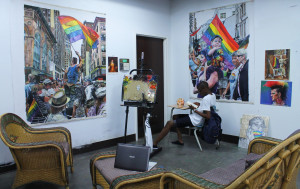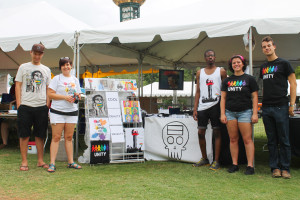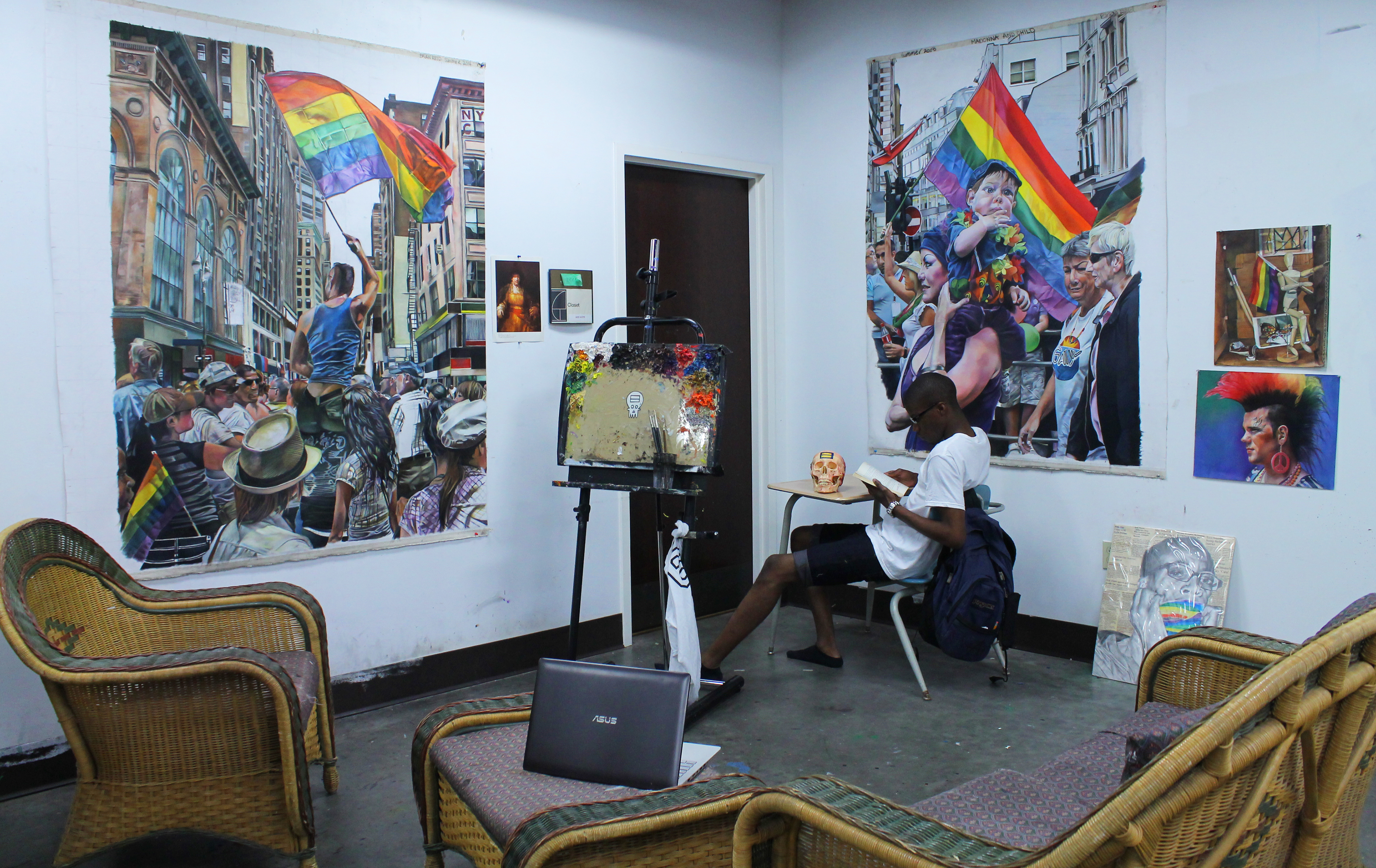Brian Reid paints his legacy as The Equalizer, a pride artist

Among his nook of canvas paintings in an upstairs studio of Clayton B, Brian Reid sets up his own camcorder. He is recording his interview for his senior project. The camera hangs over him and his creations: four years in the making.
There are people on the canvases. On some, the familiar rainbow banner binds their mouths. On others the same banner flies free in a busy crowd of people looking onward. Reid sits to share his story as an artist.
In middle school, Reid had a knack for acting up in class. He loved to show off, especially his sketches. It was in middle school that he started to become aware of his identity. He loved to draw the human form and would take pictures or have people model for him so he could capture their image.
His outlet for self-discovery was drawing and sketching. His drawing and sketching would lead others to discover him. It was in high school that Reid would begin to receive positive attention from his peers as a formidable artist.
“I like attention, I guess,” said Reid with a chuckle, “I don’t like to admit that, but maybe I do.”
Reid honed his craft after transferring to Walker School. His teacher Laura Stewart taught Reid his characteristic shading technique in sketching. Reid would later employ this technique as he started painting, which is now his primary medium.
By high school, Reid had become aware and sympathetic to the LGBTQ community. He was no longer ashamed of his feelings and wanted to help to spread awareness and support. His AP Art class is where he thought he could make his statement.
As part of the course, he had to assemble a portfolio of 12 assignments, his chosen theme would be Pride parades. The portfolio would be his coming out piece. His method was to go to festivals, and take pictures of people at the festivals, borrow several images and draw his own scene out of real moments. This is still his method for source material today.
“It was really hard for me to tell my parents,” said Reid, “We never talked about gay people that I can remember. For some reason, it was so hard for me to say that I was gay to them. I don’t know where it came from that we just thought it was a bad thing.”
Reid recounts attempting to tell his mother over dinner at a Cici’s Pizza, that he would need to go to a Ppride parade, dancing around his confession all through dinner to the last ice cream but never quite being able to say it to her.
Later that week, he ran into her room, told her and ran out afraid for what she may think. She was not upset at all and loved him as only mothers do. While his father was equally supportive, Reid remembers his father expressing concern about putting himself out for scrutiny.
“I just felt like it was something I had to do. I couldn’t just stand in the crowd,” said Reid, “If you are silent, people will make decisions for you. If someone asks you if you are gay and you say no, by saying no you are accepting the fact that it is a bad thing and that in society we should hide in the closet.”
Reid has never looked back.
One of the objectives of Reid’s work is to get more people out of the closet and to de-marginalize the LGBTQ community, especially among high school age adolescents.
“A lot of my work is aimed towards the struggle of high school and adolescent children. Kids need this to know that there are people out there that do care about them. You can grow up in a community that does not acknowledge the Community,” said Reid.
One popular image in Reid’s work is the painted rainbow tape over the mouth of many of his models. He explains:
“The rainbow tape really symbolizes the closet,” said Reid. “What is the closet, anyways? It’s a cop-out word. Most people can’t even say gay without getting uncomfortable.”
Reid says people ask a lot of questions, many of which make it very difficult to rip off the tape.
“People are constantly asking you as if it’s their problem. I feel as a culture we have a different aesthetic to us. A lot of us have higher voices. That was one of my big problems. I really want to tackle that as a piece sometime in the future,” said Reid.
Reid is looking forward. He sells his paintings at festivals and spreads the word about his cause while making a living as an artist. He also has his own clothing line, Equalizer Co., with t-shirts featuring his work.
Several MC students go with him and help him work his tent and they pass out fans in the shape of his trademark skull insignia with the equality symbol emblazoned on the forehead. He calls them “Gregs,” after Gregor Samsa from Franz Kafka’s The Metamorphoses. They are a symbol of the oppression felt by members of the LGBTQ community.
His work is available online at ThePrideArtist.com. Reid employs, Tumblr, Instagram, and Facebook to spread his message.
Reid is working now on his senior show. His performance will begin with a speed drawing video of two of his latest pieces and end with his final piece. It will be played over a song and beat that he has gotten produced. It will be a piece culminating all he has learned in his four years at Maryville College.

Denny.

